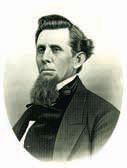Milam County Historical Commission
Milam County, Texas
Milam County, Texas






All articles from the Temple Daily Telegram are published with the permission of the
Temple Daily Telegram.
All credit for this article goes to
Jeanne Williams and the Temple Daily Telegram
Temple Daily Telegram.
All credit for this article goes to
Jeanne Williams and the Temple Daily Telegram
Texas War Vet Led Exodus
Port Sullivan pioneers joined Mormon wagon train to Utah
Backroads by Jeanne Williams
Temple Daily Telegram - April 26, 2010
PORT SULLIVAN — The settlement of Port Sullivan was one of many Texas villages that
dried up and blew away into the chronicles of the Lone Star State’s heritage. It was
added to historical marker lists and ghost town rosters, yet the east Milam County 19th
century claims important ties to some Utah families and The Church of Jesus Christ of
Latter Day Saints.
In 1854, the Mormon Church dispatched elder Seth M. Blair on a mission trip to Port
Sullivan. Blair preached the Mormon doctrine and welcomed 50 new converts into the
faith, using the Brazos River for baptisms. Blair also persuaded his newly acquired
flock to make their homes in Salt Lake City, Utah Territory. Blair, an attorney, and
veteran of the Texas war for independence and celebrated figure in Utah history, was a
respected leader in his church, and friend of The Church of Jesus Christ of Latter-Day
Saints President Brigham Young.
Blair led his party of saints out of Port Sullivan on March 9, 1855, in a wagon train
that moved slowly northward into Falls County purposely to accommodate latecomers. Among
Mormon saints departing Port Sullivan was Georgia native and former Texas state
representative Nathaniel Hunt Greer, his wife Nancy, and their children. Greer operated
a prosperous sawmill in Milam County. The Greers sold their properties in Milam and
Washington counties and bought wagons, oxen and supplies for their overland wagon train
journey to Utah.
Blair’s journal recorded his visit to Texas, events in Port Sullivan, and the wagon
train to Utah according to documents at the LDS Church Library in Salt Lake City.
By March 25, the party was six miles north of Marlin. The weather was dry and windy,
stunting grasses needed for livestock forage. Near Waxahachie, Blair expressed in his
diary dismay because envy, jealousy, worldliness and loss of the spirit had crept in
among his followers.
The slow-moving caravan departed Texas on April 22, crossing the Red River at Preston.
They traveled through Choctaw and Chickasaw land. The Texas group joined a larger wagon
train of Utah-bound Mormons in Atchison, Kansas Territory.
The overland wagon train of 89 people, 38 wagons, 480 oxen, 21 cows and 40 horses
departed Atchison on June 15, only to be stricken with a cholera epidemic after
traveling only 20 miles. In the first 24 hours, a dozen people died of cholera that
eventually claimed 29 victims, 16 from Texas and 13 others.
The train continued leaving in its wake a trail of graves. Nathaniel Greer was among the
casualties. His coffin was made from a wagon bed and he was buried on a hill close to
Grasshopper Creek. Another cholera-stricken Port Sullivan pilgrim wandered away from
camp and was never found. “The cry of the dying and shrieks of the living presented
nothing but the true scene, even all the horrors of death imaginable. The gravediggers
were employed both night and day,” Blair wrote in his journal on June 14, 1855. When the
party reached the Big Nemehaw River, many survivors renewed their covenants through re-
baptism.
The train continued, but the people had to deal with a measles outbreak, distention, a
few accidents and the threat of Indian attacks that terrorized travelers, but never
occurred. They reported they had fed a few Sioux. Greer’s grief-stricken family plodded
on across the plains with the overland train arriving in Salt Lake City on Sept. 11,
1855.
A year later, some of Greer’s offspring, heartbroken over the loss of their father, and
disheartened over the loss of cattle during a brutal Utah winter, returned to Texas and
settled in Bosque County. Others stayed in Utah. One of Greer’s granddaughters married
Blair.
Blair, who had longtime friends in Texas, was reported to have corresponded with Sam
Houston in the early days of Texas.
The Handbook of Texas On Line sets Port Sullivan geographically on a low bluff
downstream from a shoal of limestone boulders in the Brazos River about 25 miles east of
Cameron in Milam County.
Officially, the village was christened Port Sullivan on Dec. 12, 1835, when August W.
Sullivan gained title to the property.
In 1852, Port Sullivan boasted 200 residents, four stores including one stocked with New
York-bought goods, a sawmill, warehouses, post office and offices for doctors and
lawyers. By 1860, the town had grown to 680 and had its own college.
The 1870 census counted 1,423 people, but a decade later only 123 people remained. By
the 1890s Port Sullivan had reached ghost town status, the unsuspecting victim of a
temperamental river that could only accommodate steamboats during floods, and a casualty
of 19th century transportation when railroads laid tracks at other sites isolating the
village.
During its existence, Port Sullivan recorded some notable events. Robert E. Lee was
among soldiers stationed at Port Sullivan before the Civil War to quell unfriendly
Indian uprisings.
The Port Sullivan Cemetery is the resting place of Thomas J. Anderson, grand master of
Masons of Texas who died in office in 1871. His grave is marked with a 9-foot marble
monument. The site was honored several years ago with a Texas Historical Marker placed
during ceremonies sponsored by the San Andres Masonic Lodge No. 107 in Cameron.

Mormon Missionary Seth Blair visited Port Sullivan in Milam County
photo courtesy of LDS Church
photo courtesy of LDS Church